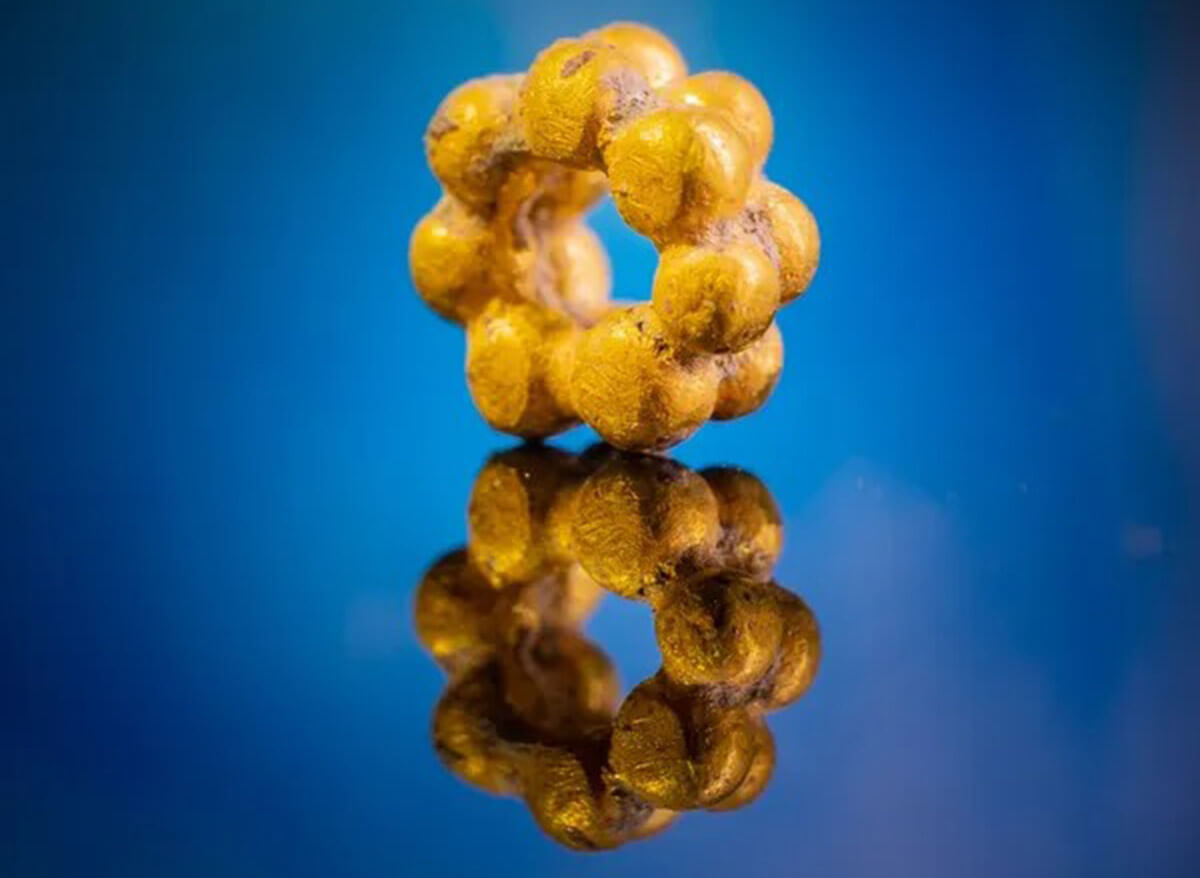Archaeologists discover rare 1600-year-old gold bead in Jerusalem
Discovered in a Late Roman building in the ‘City of David,’ the bead is one of few gold jewels ever found in the area, archaeologists say

A gold bead discovered during excavations in the City of David in East Jerusalem. Photo by Kobi Harati
This article originally appeared on Haaretz, and was reprinted here with permission. Sign up here to get Haaretz’s free Daily Brief newsletter delivered to your inbox.
An exquisite gold bead crafted in Mesopotamian style has been found during excavation of a Roman structure by the stepped Pilgrimage Road in the so-called “City of David,” the Israel Antiquities Authority revealed on Wednesday.
The bead was found in pristine condition by Hallel Feidman, a volunteer sifting and washing dirt removed from the Roman building, itself a big, ornate construction. It can’t be dated but the building where it was lost can. It is from the Late Roman era, about 1,600 years ago.
Made of pure gold, the bead was crafted by affixing tiny golden spheres together to shape a tiny ring. It likely wouldn’t have been worn in solo glory like a pendant but probably formed part of a bigger piece, says Dr. Amir Golani, the IAA’s ancient jewelry expert.
Announcing the discovery of a single bead is rather unusual but to do the micro-artifact justice, it is an extraordinary find. Also, its exquisite material and crafting attest to the high rank of its owner, if not the circumstances of its loss.
Another reason to celebrate is that finding gold in any form in archaeological sites is extremely infrequent – “Throughout all my years in archaeology, I have found gold perhaps once or twice,” Golani says. That is because gold has been a precious metal since the dawn of metallurgy and remains coveted to this day, Golani explains. If one had gold in any form, one would hand it down to one’s heirs until it got stolen, whether by muggers or robbers of home or grave.
How this particular gold bead survived the ages in situ, only to pop up shining splendidly while Feidman sifted dirt from the Roman manse in the City of David must remain speculative. “It may have been part of a bigger piece that broke apart and this bead got lost,” Golani speculates. “The circumstances of finding it are serendipity. It wasn’t hidden: it had to have been lost. Nobody throws a thing like this away. Maybe it rolled under a furnishing.”
The metallurgical technique underlying the bead emerged in Mesopotamia around 4,500 years ago, the IAA says, and its manufacture speaks to great skill. “Understanding of the materials and their properties is required, as well as control over the heat, to solder the tiny balls together to create a tiny ring on the one hand, while preventing overheating which could melt the gold,” Golani says.
Gold caches from antiquity have been found here and there in Israel, including a 1,400-year-old hoard from the period of the Muslim conquest found in Jerusalem but finding any gold is rare.
Why that might be in a land riddled with archaeological remains can be imagined. One can imagine that any gold left lying around, unlike say a broken pot, would be picked up, which explains that.
Other finds in the building attesting to the status of its occupants are imported ceramics and the quality mosaic floor, Shlomo Greenberg and Ari Levy of the IAA said. But theoretically the bead could have originated in an earlier time.
There is no reason to think the bead was made in Jerusalem, the archaeologists add. It could have been made anywhere and reached the Holy Land at any time, through trading networks, for instance.
Beads of similar style but made of silver have been discovered in burial caves from the late First Temple period, about 2,500 years ago, in Ketef Hinnom near the City of David, during excavations carried out by Professor Gabriel Barkay, the IAA said. All told only a few dozen gold beads have been found in Israel. The rest have not survived the cupidity of the ages.
The Forward is free to read, but it isn’t free to produce

I hope you appreciated this article. Before you go, I’d like to ask you to please support the Forward.
Now more than ever, American Jews need independent news they can trust, with reporting driven by truth, not ideology. We serve you, not any ideological agenda.
At a time when other newsrooms are closing or cutting back, the Forward has removed its paywall and invested additional resources to report on the ground from Israel and around the U.S. on the impact of the war, rising antisemitism and polarized discourse.
This is a great time to support independent Jewish journalism you rely on. Make a gift today!
— Rachel Fishman Feddersen, Publisher and CEO
Support our mission to tell the Jewish story fully and fairly.
Most Popular
- 1

Fast Forward Ye debuts ‘Heil Hitler’ music video that includes a sample of a Hitler speech
- 2

Opinion It looks like Israel totally underestimated Trump
- 3

Culture Is Pope Leo Jewish? Ask his distant cousins — like me
- 4

Fast Forward Student suspended for ‘F— the Jews’ video defends himself on antisemitic podcast
In Case You Missed It
-

News In Edan Alexander’s hometown in New Jersey, months of fear and anguish give way to joy and relief
-

Fast Forward What’s next for suspended student who posted ‘F— the Jews’ video? An alt-right media tour
-

Opinion Despite Netanyahu, Edan Alexander is finally free
-

Opinion A judge just released another pro-Palestinian activist. Here’s why that’s good for the Jews
-
Shop the Forward Store
100% of profits support our journalism
Republish This Story
Please read before republishing
We’re happy to make this story available to republish for free, unless it originated with JTA, Haaretz or another publication (as indicated on the article) and as long as you follow our guidelines.
You must comply with the following:
- Credit the Forward
- Retain our pixel
- Preserve our canonical link in Google search
- Add a noindex tag in Google search
See our full guidelines for more information, and this guide for detail about canonical URLs.
To republish, copy the HTML by clicking on the yellow button to the right; it includes our tracking pixel, all paragraph styles and hyperlinks, the author byline and credit to the Forward. It does not include images; to avoid copyright violations, you must add them manually, following our guidelines. Please email us at [email protected], subject line “republish,” with any questions or to let us know what stories you’re picking up.














